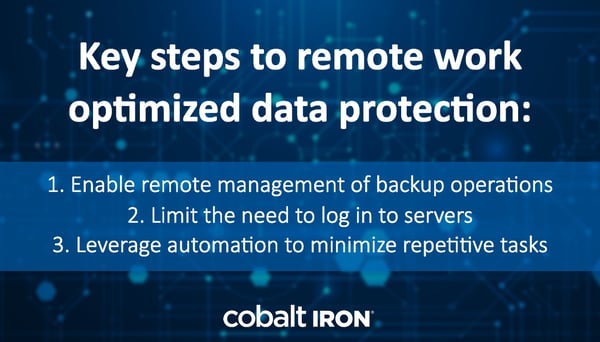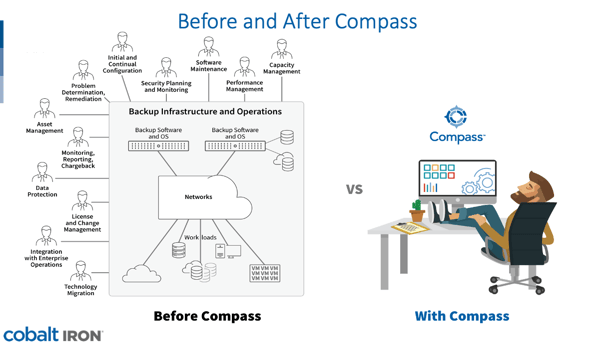 Remote work policies, globalized teams, and demands for flexibility have all made the push to remote work culture more significant. With the current global pandemic, companies who may have been considering plans to transition to remote are finding themselves scrambling to transition all their operations on a compressed timeline.
Remote work policies, globalized teams, and demands for flexibility have all made the push to remote work culture more significant. With the current global pandemic, companies who may have been considering plans to transition to remote are finding themselves scrambling to transition all their operations on a compressed timeline.
This poses obvious challenges for enterprise backup and recovery administration. Often these operations require “boots on the ground” for manual management of daily tasks.
At Cobalt Iron, we have seen how fragile and cumbersome enterprise backup management can be even when everything is going well. Enterprise environments often include multiple software solutions, multiple expensive appliances with costly overprovisioning, and time-consuming manual management - like needing to log into every server just to check if a backup successfully ran.
So how can you keep your workflows secure and updated, and ensure business continuity when your administrators can’t physically be at the data center?
Here are key areas to consider for resilient data protection in any circumstance:

Enable remote management of backup operations
While a web-based dashboard can be great for seeing what happened, it doesn’t allow you and your team to actually make any changes or troubleshoot issues.
We built the Compass™ platform to not only automate up to 90% of daily management tasks but to simplify and consolidate data protection across your entire environment. Unlike a typical “dashboard,” the web-based interface for Compass, called Commander, allows users to take action and deploy changes in the data center and see the status in real time of their environment.
Life as Backup Administrator: Before and After
“From that same web interface [Commander], I could download code specific to the operating system of each client… the system installed and configured the code, then configured the services required.” Read more>>
The Commander interface is available wherever you have an internet connection. Suddenly, needing to be remote all or most of the time seems a lot more realistic for backup admins.
Limit the need for logging in
Logging directly into servers is risky but often considered necessary. However, leveraging a data protection solution that creates a gap between individual users and the servers themselves increases the security of your workflows.
If you are able to deploy changes, check the success rates of your backups, manage users and roles without ever needing to log directly into the server, your data has a line of defense against cyberattacks or manual errors.
Because Compass automatically manages the tasks typically done manually, human intervention decreases and security increases. Also, users manage the environment via the Commander web interface, so the need to log directly into the server is eliminated. Even upgrades are automatically delivered to your environment.
Leverage automation
IT Teams are strapped for resources even in the best of times. Leaders are thinking of ways to do more with less, or at minimum be prepared if a team is suddenly unavailable.
Modern data protection techniques like analytics-driven automation may seem out of reach for complex, enterprise environments with terabytes or petabytes of data to manage. Automation is foundational to the Compass™ architecture, which was built with the most complex environments in mind.
It is possible to automate and eliminate the majority of daily manual management tasks. This automation in Compass frees up resources for value-add tasks, reducing overall costs.

What is the next step for your team?
Having a backup environment as flexible and robust as possible can mean the difference between business as usual and closing your doors. Leaders who plan for resiliency are the unsung heroes in times of chaos. We built Compass to help those leaders transform their operations and create more value with their data.
We want to help you succeed in the face of an uncertain future. Learn more about how quickly you could migrate to the leading data protection technology for enterprise companies by scheduling a consultation here >>
< Back to Blog